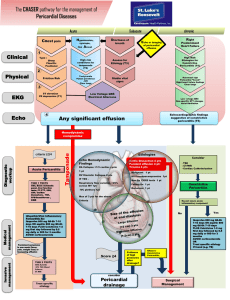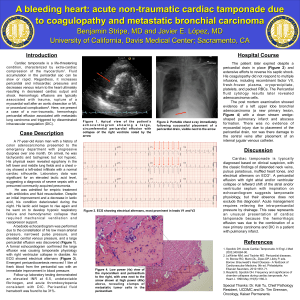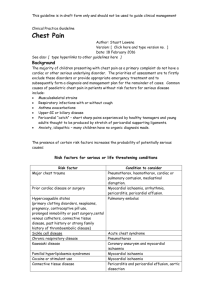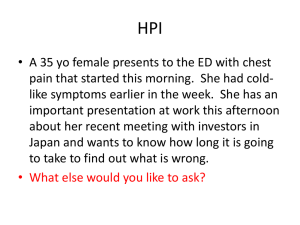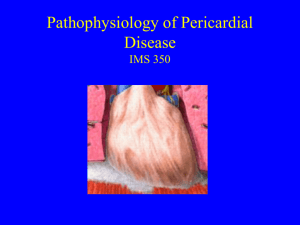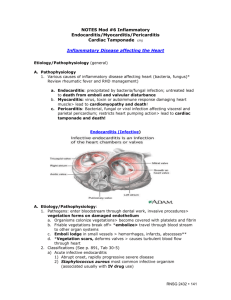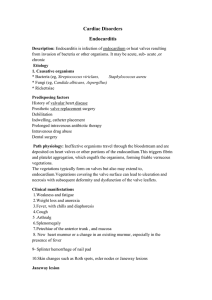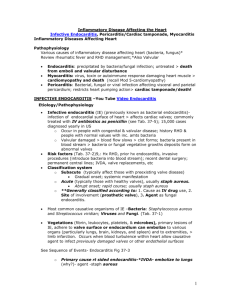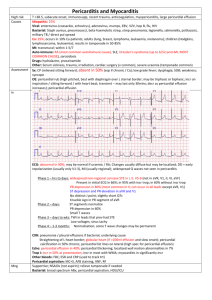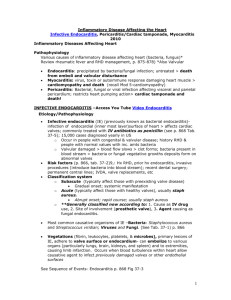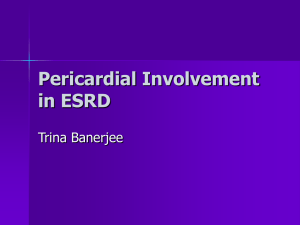Pericardial Diseases
advertisement
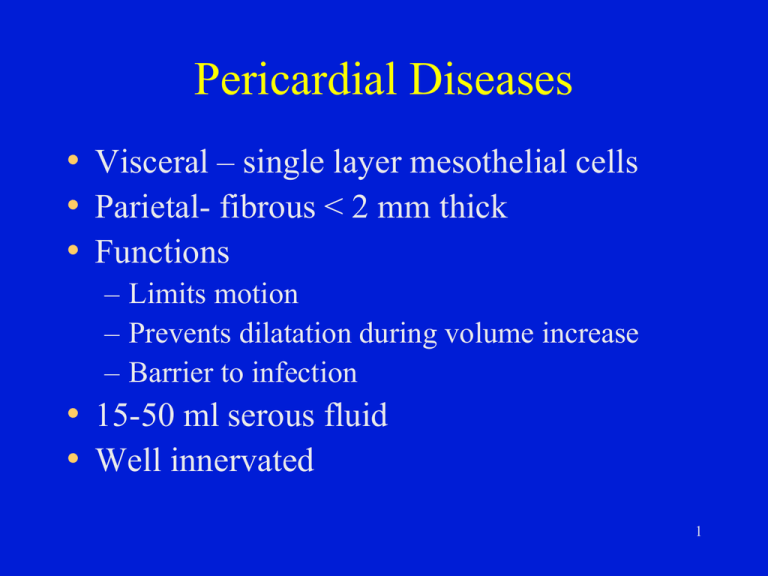
Pericardial Diseases • Visceral – single layer mesothelial cells • Parietal- fibrous < 2 mm thick • Functions – Limits motion – Prevents dilatation during volume increase – Barrier to infection • 15-50 ml serous fluid • Well innervated 1 Acute Pericarditis Etiology • Infectious – Viral – Bacterial – TB • Noninfeccious – – – – – – – Post MI (acute and Dresslers) Uremia Neoplastic disease Post radiation Drug-induced Connective tissue diseases/autoimmune traumatic 2 Infectious • Viral (idiopathic) – – – – Echovirus, coxsackie B Hepatitis B, influenza, IM, Caricella, mumps HIV, TB Bacterial (purulent) • Pneuococcus, staphlococci • fulminant 3 Pericarditis post- MI • Early <5% patients • Dressler’s 2 weeks – months – Autoimmune • Post-pericardiotomy 4 Neoplastic • • • • • Breast Lung Lymphoma Primary pericardail tumors rare Hemmorrhagic and large 5 • Radiation – Dose > 4000rads – Local inflammation • Autoimmune – SLE – RA – PSS (40% may develop) • Drugs-lupus like – – – – – Hydralazine Procaimamide Phenytoin Methyldopa Isoniazid • Drugs- not lupus – Minoxidil – Anthracycline antineoplastic agents 6 Pathogenesis and Pathology • Inflammatory – Vasodilation – Increased vascular permeability – Leukocyte exudation • Pathology – Serous-little cells – Serofibrinous – rough appearance / scarring • common – Purulent – intense inflammation – Hemmorrhagic – TB or malignancy 7 Clinical • Chest pain – Radiate to back – Sharp and pleuritic – Positional – worse lying back • Fever • Dyspnea due to pleuritic pain 8 Chest pain in Pericarditis • เจ็บบริเวณหลังต่ อกระดูก sternum • เจ็บมากเวลาหายใจ และเวลานอนหงาย • เจ็บน้ อยลงเวลาลุกนั่ง และ โน้ มตัวไปด้ านหน้ า Exam • Friction rub – Diaphragm leaning forward – 1, 2 or 3 components • Ventricular contraction, relaxaltion, atrial contraction – intermittent 10 Diagnostic • Clinical history • ECG – Abn in 90% – Diffuse ST elevation – PR depression • Echocardiography – Effusion • PPD • Autoimmune antibodies • Evaluate for malignancy 11 (Circulation. 2006;113:1622-1632.) 12 EKG in Pericarditis (Circulation. 2006;113:1622-1632.) 14 Treatment • ASA or NSAIDs – Avoid NSAID in MI • Colchicine • Steroids - avoid – May increase reoccurance • • • • TB – Rx TB Purulent – drainage of fluid + antibiotics Neoplastic- drainage Uremic - dialysis 15 Pericardial Effusion • From any acute pericarditis • Hypothyriodism- increased capillary • • • • permeability CHF- increased hydrostatic pressure Cirrhosis- decreased plasma oncotic pressure Chylous effusion- lymphatic obstruction Aortic Dissection 16 Effusion Pathophysiology • Pericardium is stiff- PV curve not flat • Above critical volume – rapid increase in pressure • Factors that determine compression – Volume – Rate of accumulation – Pericardial compliance 17 Clinical • Asymptomatic • Symptoms – CP, dyspnea, dysphagia, hoarseness, hiccups • Tamponade • Exam – Muffled heart sounds – Absence of rub – Ewarts sign-dullness L lung at scapula • atelectasis 18 Diagnostic studies • CXR - > 250 ml fluid globular cardiomegaly • ECG low voltage and electrical alternans • Echocardiogram most helpful – Identify hemodynamic compromise 19 ECG low voltage and electrical alternans 20 Treatment • If known cause- treat that • If unknown- may need pericardiocentesis or pericardial window • Cardiac tamponade is emergencypericardiocentesis drainage or window 22 Tamponade • Any cause of effusion may lead to • Diastolic pressures elevate and = pericardial • • • • pressure Impaired LV/RV filling Increased systemic venous pressure Decreased stroke volume and C.O. Shock 23 Tamponade • Have right side failure with edema and fatigue only if occurs slowly • Key physical findings: – JVD – Hypotension – Small quiet heart • Sinus tachycardia • Pulsus paradoxus- decease in BP > 10 during normal inspiration 24 Pulsus Paradoxus • Exaggeration of normal • Normally septum moves toward LV with inspiration, with decrease in LV filling • With compression and fixed volume, there is even greater limitation in LV filling and reduced stroke volume • PP also seen in COPD/asthma 25 Tamponade • Echocardiography – Compression of RV and RA in diastole – Can have localized effuison with localized compression of one chamber (RA,LV) • Effusion post cardiac surgery – Differentiate other causes of low cardiac output • Cardiac catheterization- definitive – Measure pressures- chamber and pericardial equal, and all elevated. 26 Tamponade- external compression blunts filling throughout cardiac cycle 27 Lancet 2004; 363: 717–27 28 29 30 Pericardial Fluid • • • • Stained and cultured Cytologic exam Cell count Protein level – pp/sp> 0.5 - exudate • LDH level – p LDH/ s LDH > 0.6 - exudate • Adenosine Deaminase level - sensitive and specific for TB 31 Constrictive Pericarditis • • • • Most common etiology is idiopathic (viral) Any cause of pericarditis Post cardiac surgery Pathology – Organization of fluid, scarring, fusion of pericardial layers, calcification 32 Constrictive Pericarditis • Impaired diastolic filling of the chambers • Elevated systemic venous pressures • Reduced cardiac output • Dip and plateau curve on catheterization 33 Constrictive Pericarditis Clinical • Symptoms – Fatigue, hypotension, tachycardia – JVD, hepatomegaly and ascites, edema • Can confuse with cirrhosis- look for JVD • Exam – Pericardial knock after S2- sudden cessation of ventricular diastolic filling • Kussmaul’s sign- JVD with inspiration • No pulsus paradoxus • Difficult to separate from restrictive cardiomyopathy- may need myocardial biopsy 34 Am Heart J 1999;138:219-32 35 Normal pericardium < 2 mm 36 (Circulation. 2006;113:1622-1632
